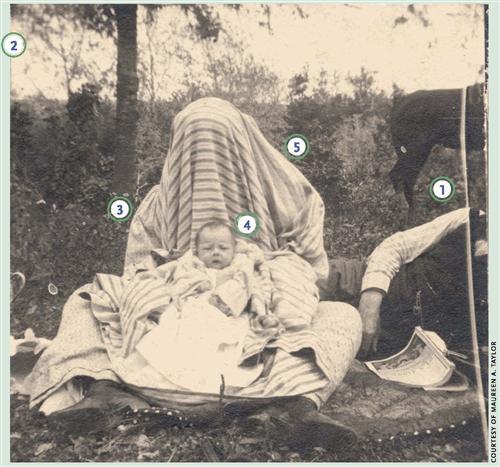Sign up for the Family Tree Newsletter Plus, you’ll receive our 10 Essential Genealogy Research Forms PDF as a special thank you!
Get Your Free Genealogy Forms
"*" indicates required fields
Imagine trying to identify this photograph of a woman we’ll assume is Mom “posed” under a picnic blanket for a candid shot with the baby as the focus. For one, you can’t see anyone’s face but the infant’s-and don’t babies all look alike, anyway? There’s no telling whether the little one’s a boy or girl: His or her fuzzy little head means you can’t rely on the tried-and-true rule that girls wore center parts and boys combed their hair to the side. Costume clues are usually helpful, but only one sleeve and the soles of this woman’s shoes show. The man to her left is no help; he’s barely visible. And baby dresses don’t narrow dates much because the styles rarely changed and families handed down kids’ clothes. The only prop here—the magazine—is placed at an angle and is impossible to decipher.
You probably have a few images that similarly lack important clues from faces, clothing and props. Don’t throw up your hands-instead, use them to wring more information out of what’s there.
Even though it’s missing chunks of the story, this picture does contain evidence to help identify the subjects and establish a date range. A magnifying glass or photographer’s loupe (available from photo supply stores) will dehitely come in handy as you study the following:
? Professional pointers: Professional photos are much more likely than candids to feature clue-rich details such as a photographer’s imprint, props and outfits. You can tell a friend or family member likely snapped this shot by the way the man and horse are cut out of the frame. Other clues to an amateur photo include an odd camera angle or slightly blurry image.
? Measurements: The picture’s dimensions, 2% inches square, may reveal the photographer. Only two cameras produced images this size during the early 20th century: the Kodak Brownie, introduced in 1900, and Ansco’s Buster Brown No. 1, first available in 1906. Kodak marketed its camera directly to children with illustrator Palmer Cox’s sprightly Brownie character. Kodak’s overwhelming success led Ansco to market a competitor using Buster Brown dimensions, century: and his dog Ti, comic strip characters who debuted in a 1902 New York Herald. Both models were popular for years, so they provide a starting date but not an ending one. Of course, we can’t say for sure whether a child took this picture, but since the cameras were made for youngsters, it’s quite possible the shutterbug was an older sibling.
? Parts of clothing: Look carefully and you may glimpse a slice of a shirt or dress, such as the woman’s right sleeve peeking from beneath the blanket’s edge. (Scanning and enlarging your photo can help you spot such minute details). According to Joan Severa in Dressed for the Photographer: Ordinary Americans and Fashion, 1840-1900 (Kent State University Press), women’s dresses featuring full upper sleeves and long skirts were popular between 1900 and 1910 — a time frame that agrees with the camera’s manufacture date.
? Developmental milestones: This tiny infant can barely hold up its head unsupported, so he or she is probably around 3 months old. Developmental markers, such as sitting unassisted, holding a rattle, smiling and walking, can help you estimate babies’ ages. You’ll find lists of age-related feats in child-development and parenting books such as What to Expect the First Year, 2nd edition, by Heidi Murkoff, Sandee Hathaway and Arlene Eisnberg (Workman Publishing Co.).
To estimate the ages of older children, look at their ankles: A girl’s skirt became gradually longer as she approached adulthood; boys wore short pants until they were teenagers.
? Genealogical data: I purchased this intriguing picture, but if these were my relatives, the next step would be to examine my research for babies born from 1900 to 1910 (plus a few years on each side to be safe) — possibly with older siblings. Once I had a short list of ancestral suspects, I’d show this picture to other family members and compare it to their albums for already-identified photos showing the same baby or setting.
You might feel clueless when you encounter a mystery photo that seems to lack any telling evidence, but there’s no need. Research the photo’s size and closely examine the image for small details — soon you’ll declare “case closed.”
1. Half time. The cut-off horse and man hint at an amateur photographer.
2. Size matters. Snapshot size can reveal which camera took the shop.
3. Ace up your sleeve. This woman’s puffed, full sleeve suggests a 1900-to-1910 time frame.
4. Baby steps. Most infants can just hold up their heads at 3 months.
ADVERTISEMENT


